The global optical extinction analyzer market is valued at USD 1,673.3 million in 2025 and is projected to reach USD 3,025.0 million by 2035, growing at a CAGR of 6.1% and expanding by nearly 1.8 times during this period. On the supply side, the optical extinction analyzer market is shaped by a mix of component availability, production capabilities, technological precision, and alignment with industry-specific requirements. Manufacturers rely heavily on advanced lasers, detectors, and optical sensors, making semiconductor supply chains a critical determinant of cost and delivery schedules. Any disruption in these upstream inputs, such as silicon photonics components or precision optics, directly affects pricing stability and output capacity. Suppliers with established sourcing networks and backward integration into component manufacturing are in a stronger position to mitigate volatility.
Production capacity trends show increasing automation in assembly and calibration to deliver the high precision demanded in pharmaceutical, aerospace, and chemical applications. Leading producers are adopting advanced cleanroom environments, automated alignment systems, and AI-driven quality control checks to maintain consistency across large batches of analyzers. This not only reduces error margins but also helps scale up production volumes as demand accelerates from regulated industries. Miniaturization and portability are influencing design choices, pushing suppliers to invest in compact laser modules and efficient thermal management systems to meet market expectations for field-ready equipment.
Geographic concentration of supply is another trend. Asia Pacific is emerging as a cost-efficient manufacturing hub due to strong semiconductor ecosystems in China, Japan, and South Korea, while Europe and North America focus on premium analyzers for high-value research and compliance-driven sectors. This split is leading to tiered supply chains where low-cost, high-volume products are balanced by high-precision, premium instruments targeted at regulated markets. Partnerships between local distributors and global suppliers are expanding reach, particularly in emerging economies where infrastructure for high-tech instrumentation is developing rapidly. Competitive dynamics on the supply side are defined by differentiation in accuracy, multi-functionality, and compliance readiness. Firms that provide instruments certified under ISO or GMP standards gain preference in sectors like pharmaceuticals and food processing, where validation is critical. Another trend is the integration of software-driven enhancements, with suppliers bundling real-time analytics platforms and cloud-based monitoring tools to increase the value proposition.
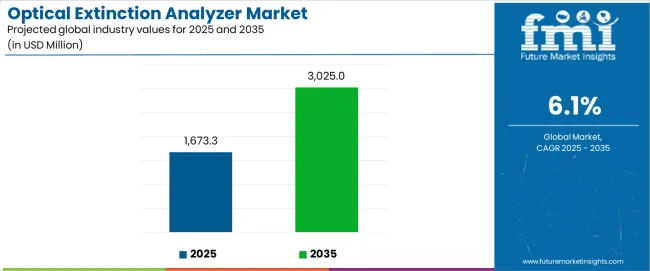
Between 2025 and 2030, the optical extinction analyzer market is projected to expand from USD 1,673.3 million to USD 2,249.8 million, resulting in a value increase of USD 576.5 million, which represents 42.6% of the total forecast growth for the decade. This phase of development will be shaped by increasing demand for precision analytical solutions, rising research and development activity enabling advanced characterization techniques, and growing availability of automated measurement technologies across pharmaceutical quality control operations and chemical analysis facilities.
Between 2030 and 2035, the optical extinction analyzer market is forecast to grow from USD 2,249.8 million to USD 3,025.0 million, adding another USD 775.2 million, which constitutes 57.4% of the overall ten-year expansion. This period is expected to be characterized by the advancement of intelligent analytical systems, the integration of machine learning algorithms for data interpretation, and the development of premium detection technologies across diverse analytical applications. The growing emphasis on measurement accuracy and analytical efficiency will drive demand for advanced analyzer varieties with enhanced precision capabilities, improved detection characteristics, and superior performance profiles.
Between 2020 and 2024, the optical extinction analyzer market experienced steady growth, driven by increasing pharmaceutical research activity and growing recognition of optical analysis technology's effectiveness in delivering consistent measurement quality across laboratory and industrial applications. The optical extinction analyzer market developed as researchers recognized the potential for advanced analyzers to deliver operational efficiency while meeting modern requirements for particle size analysis and high-throughput characterization operations. Technological advancement in optical sensor technology and detection system design began emphasizing the critical importance of maintaining measurement consistency while enhancing equipment reliability and improving analytical precision rates.
| Metric | Value |
|---|---|
| Estimated Value in (2025E) | USD 1,673.3 million |
| Forecast Value in (2035F) | USD 3,025.0 million |
| Forecast CAGR (2025 to 2035) | 6.1% |
From 2030 to 2035, the optical extinction analyzer market is forecast to grow from USD 2,249.8 million to USD 3,025.0 million, adding another USD 775.2 million, which constitutes 57.4% of the overall ten-year expansion. This period is expected to be characterized by the advancement of digital measurement monitoring systems, the integration of automated calibration accessories for measurement efficiency, and the development of specialized optical configurations for enhanced detection patterns. The growing emphasis on instrument longevity and analytical precision will drive demand for premium varieties with enhanced stability credentials, improved compatibility options, and superior functionality characteristics.
Between 2020 and 2024, the optical extinction analyzer market experienced robust growth, driven by increasing awareness of analytical quality benefits and growing recognition of optical systems' effectiveness in supporting efficient characterization operations across research facilities and commercial testing services. The optical extinction analyzer market developed as users recognized the potential for specialized analyzers to deliver productivity advantages while meeting modern requirements for consistent measurement quality and reliable instrument performance. Technological advancement in optical component manufacturing processes and quality assurance systems began emphasizing the critical importance of maintaining calibration standards while extending analyzer service life and improving customer satisfaction across diverse analytical applications.
Market expansion is being supported by the increasing global demand for precise analytical solutions and the corresponding shift toward high-performance instruments that can provide superior measurement characteristics while meeting user requirements for equipment reliability and cost-effective maintenance processes. Modern laboratories are increasingly focused on incorporating analytical systems that can enhance productivity while satisfying demands for consistent, precisely controlled measurement patterns and optimized material characterization practices. Optical extinction analyzers' proven ability to deliver analytical efficiency, equipment protection, and diverse application possibilities makes them essential components for research laboratories and quality-conscious analytical professionals.
The growing emphasis on precision measurement and instrument optimization is driving demand for high-performance analytical systems that can support distinctive characterization outcomes and comprehensive equipment protection across pharmaceutical analysis, chemical characterization, and specialty testing applications. User preference for analyzers that combine functional excellence with operational flexibility is creating opportunities for innovative implementations in both traditional and emerging analytical applications. The rising influence of automated analysis processes and advanced instrument technologies is also contributing to increased adoption of specialized analyzers that can provide authentic performance benefits and reliable operational characteristics.
The optical extinction analyzer market is segmented by analyzer type, application, detection method, measurement range, and region. By analyzer type, the optical extinction analyzer market is divided into spectrophotometry-based extinction analyzers, laser light scattering extinction analyzers, multi-angle light scattering analyzers, dynamic light scattering analyzers, and others. Based on application, the optical extinction analyzer market is categorized into the chemicals industry, the pharmaceuticals industry, the food and beverages industry, the aerospace industry, the environmental monitoring industry, and others. By detection method, the optical extinction analyzer market includes single-angle detection, multi-angle detection, and combined detection systems. By measurement range, the optical extinction analyzer market encompasses nano-scale analyzers, micro-scale analyzers, and multi-scale analyzers. Regionally, the optical extinction analyzer market is divided into North America, Europe, Asia Pacific, Latin America, the Middle East & Africa, and other regions.
The spectrophotometry-based extinction analyzers segment is projected to account for 52.8% of the optical extinction analyzer market in 2025, reaffirming its position as the leading analyzer category. Researchers and analytical professionals increasingly utilize spectrophotometry-based analyzers for their superior measurement characteristics, established accuracy standards, and essential functionality in diverse analytical applications across multiple laboratory types. Spectrophotometry-based analyzers' proven performance characteristics and established cost-effectiveness directly address user requirements for reliable instrument operation and optimal measurement precision in research applications.
This analyzer segment forms the foundation of modern optical analysis performance patterns, as it represents the technology category with the greatest analytical impact potential and established compatibility across multiple measurement systems. Laboratory investments in advanced spectrophotometry technology and performance optimization continue to strengthen adoption among accuracy-conscious researchers. With users prioritizing measurement consistency and instrument reliability, spectrophotometry-based analyzers align with both productivity objectives and quality requirements, making them the central component of comprehensive analytical strategies.
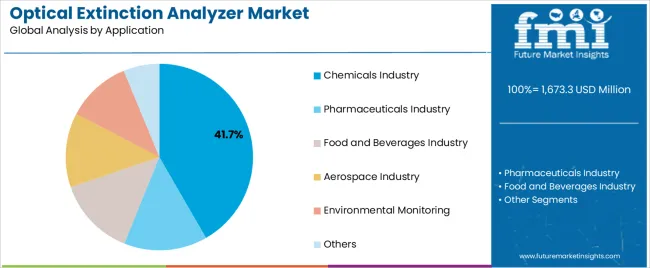
Chemicals industry is projected to represent 41.7% of the optical extinction analyzer market in 2025, underscoring its critical role as the primary application for quality-focused laboratories seeking superior analytical efficiency benefits and enhanced characterization credentials. Chemical researchers and analytical professionals prefer chemicals applications for their established measurement requirements, proven analytical demand, and ability to maintain exceptional precision quality while supporting versatile characterization requirements during diverse research projects. Positioned as essential applications for performance-conscious laboratories, chemicals offerings provide both analytical excellence and competitive positioning advantages.
The segment is supported by continuous improvement in analytical technology and the widespread availability of established measurement standards that enable quality assurance and premium positioning at the laboratory level. The chemical companies are optimizing analyzer selections to support research differentiation and competitive analysis strategies. As analytical technology continues to advance and laboratories seek efficient measurement methods, chemicals applications will continue to drive market growth while supporting research development and client satisfaction strategies.
The optical extinction analyzer market is advancing rapidly due to increasing analytical precision consciousness and growing need for advanced measurement solutions that emphasize superior performance outcomes across pharmaceutical segments and chemical applications. The optical extinction analyzer market faces challenges, including competition from alternative analysis technologies, instrument maintenance complexities, and component cost pressures affecting operational economics. Innovation in intelligent monitoring integration and advanced materials continues to influence market development and expansion patterns.
The growing adoption of optical extinction analyzers in pharmaceutical research and chemical analysis is enabling laboratories to develop characterization strategies that provide distinctive accuracy benefits while commanding competitive positioning and enhanced research completion characteristics. Pharmaceutical applications provide superior measurement consistency while allowing more sophisticated quality control features across various research categories. Users are increasingly recognizing the analytical advantages of analyzer positioning for premium measurement outcomes and efficiency-conscious research integration.
Modern optical extinction analyzer manufacturers are incorporating advanced monitoring technologies, digital measurement control systems, and automated calibration tracking to enhance analytical precision, improve instrument longevity, and meet commercial demands for intelligent measurement solutions. These systems improve analytical effectiveness while enabling new applications, including predictive maintenance programs and performance optimization protocols. Advanced monitoring integration also allows laboratories to support analytical leadership positioning and quality assurance beyond traditional measurement operations.
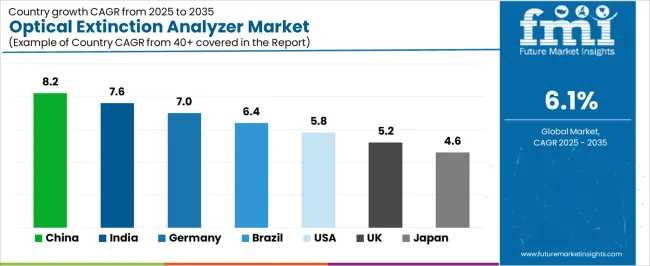
| Country | CAGR (2025-2035) |
|---|---|
| China | 8.2% |
| India | 7.6% |
| Germany | 7.0% |
| Brazil | 6.4% |
| USA | 5.8% |
| UK | 5.2% |
| Japan | 4.6% |
The optical extinction analyzer market is experiencing robust growth globally, with China leading at an 8.2% CAGR through 2035, driven by the expanding pharmaceutical industry, growing chemical research requirements, and increasing adoption of automated analysis systems. India follows at 7.6%, supported by rising research and development investment, expanding manufacturing sector, and growing acceptance of efficient analytical solutions. Germany shows growth at 7.0%, emphasizing established research capabilities and comprehensive analytical technology development. Brazil records 6.4%, focusing on chemical industry expansion and pharmaceutical research growth. The USA demonstrates 5.8% growth, prioritizing advanced analytical technologies and instrument optimization.
The report covers an in-depth analysis of 40+ countries, Top-performing countries are highlighted below.
Revenue from optical extinction analyzer consumption and sales in China is projected to exhibit exceptional growth with a CAGR of 8.2% through 2035, driven by the country's rapidly expanding pharmaceutical sector, favorable government policies toward research development, and initiatives promoting advanced analytical technologies across major industrial regions. China's position as a leading manufacturing hub and increasing focus on automated analysis systems are creating substantial demand for high-quality optical extinction analyzers in both domestic and export markets. Major pharmaceutical companies and research institutions are establishing comprehensive analytical capabilities to serve growing demand and emerging market opportunities.
Revenue from optical extinction analyzer products in India is expanding at a CAGR of 7.6%, supported by rising research investment, growing pharmaceutical development, and expanding analytical laboratory capabilities. The country's developing research sector and increasing commercial investment in advanced analytical technologies are driving demand for optical extinction analyzers across both traditional and modern analytical applications. International instrument companies and domestic distributors are establishing comprehensive operational networks to address growing market demand for quality analyzers and efficient measurement solutions.
Revenue from optical extinction analyzer products in Germany is projected to grow at a CAGR of 7.0% through 2035, supported by the country's mature research sector, established analytical standards, and leadership in instrument technology. Germany's sophisticated research infrastructure and strong support for advanced analytical systems are creating steady demand for both traditional and innovative analyzer varieties. Leading instrument manufacturers and specialty distributors are establishing comprehensive operational strategies to serve both domestic markets and growing export opportunities.
Revenue from optical extinction analyzer products in Brazil is projected to grow at a CAGR of 6.4% through 2035, driven by the country's emphasis on research expansion, pharmaceutical development, and growing analytical laboratory capabilities. Brazilian researchers and pharmaceutical companies consistently seek commercial-grade analyzers that enhance research efficiency and support analytical excellence for both traditional and modern measurement applications. The country's position as a Latin American research leader continues to drive innovation in specialized analyzer applications and commercial instrument standards.
Revenue from optical extinction analyzer products in the USA is projected to grow at a CAGR of 5.8% through 2035, supported by the country's emphasis on analytical technology advancement, instrument optimization, and advanced automation integration requiring efficient analyzer solutions. American researchers and pharmaceutical users prioritize performance reliability and analytical precision, making specialized analyzers essential components for both traditional and modern measurement applications. The country's comprehensive technology leadership and advancing analytical patterns support continued market expansion.
Revenue from optical extinction analyzer products in the UK is projected to grow at a CAGR of 5.2% through 2035, supported by established analytical standards, mature research markets, and emphasis on instrument reliability across commercial and pharmaceutical sectors. British researchers and analytical professionals prioritize quality performance and analytical consistency, creating steady demand for premium analyzer solutions. The country's comprehensive market maturity and established analytical practices support continued development in specialized applications.
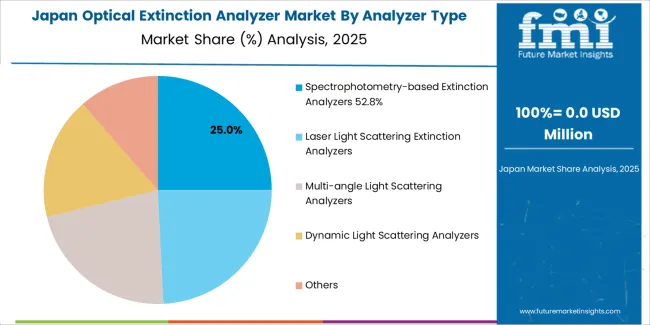
Revenue from optical extinction analyzer products in Japan is projected to grow at a CAGR of 4.6% through 2035, supported by the country's emphasis on precision manufacturing, quality excellence, and advanced technology integration requiring efficient analyzer solutions. Japanese businesses and research users prioritize technical performance and analytical precision, making specialized analyzers essential components for both traditional and modern measurement applications. The country's comprehensive quality leadership and advancing analytical patterns support continued market expansion.
The Europe optical extinction analyzer market is projected to grow from USD 549.7 million in 2025 to USD 993.2 million by 2035, recording a CAGR of 6.1% over the forecast period. Germany leads the region with a 38.4% share in 2025, moderating slightly to 37.9% by 2035, supported by its strong research base and demand for premium, technically advanced analytical instrument solutions. The United Kingdom follows with 22.8% in 2025, easing to 22.4% by 2035, driven by a mature pharmaceutical market and emphasis on instrument reliability and performance optimization. France accounts for 15.7% in 2025, rising to 16.2% by 2035, reflecting steady adoption of automated analytical solutions and operational efficiency enhancement. Italy holds 11.9% in 2025, expanding to 12.4% by 2035 as pharmaceutical research and specialty analytical applications grow. Spain contributes 6.4% in 2025, growing to 6.7% by 2035, supported by expanding research sector and instrument modernization. The Nordic countries rise from 3.6% in 2025 to 3.8% by 2035 on the back of strong technology adoption and advanced analytical methodologies. BENELUX remains at 1.2% share across both 2025 and 2035, reflecting mature, efficiency-focused research markets.
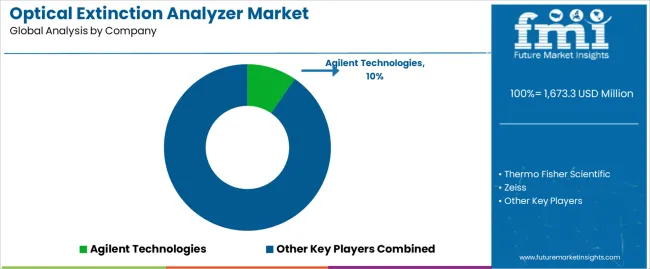
The optical extinction analyzer market is characterized by competition among established instrument manufacturers, specialized analytical equipment producers, and integrated measurement solution companies. Companies are investing in precision manufacturing technologies, advanced optical development systems, product innovation capabilities, and comprehensive distribution networks to deliver consistent, high-quality, and reliable optical extinction analyzer systems. Innovation in measurement enhancement, compatibility optimization, and application-specific product development is central to strengthening market position and customer satisfaction.
Agilent Technologies leads the optical extinction analyzer market with a strong focus on analytical instrument innovation and comprehensive optical extinction analyzer solutions, offering commercial measurement systems with emphasis on manufacturing excellence and technological heritage. Thermo Fisher Scientific provides specialized analytical instruments with a focus on research market applications and performance engineering networks. Zeiss delivers integrated optical solutions with a focus on precision positioning and analytical efficiency. PerkinElmer specializes in comprehensive analytical instrument accessories with an emphasis on pharmaceutical applications. Horiba Scientific focuses on comprehensive research analytical instruments with advanced design and premium positioning capabilities.
The success of optical extinction analyzers in meeting commercial analytical demands, laboratory-driven efficiency requirements, and performance integration will not only enhance measurement quality outcomes but also strengthen global instrument manufacturing capabilities. It will consolidate emerging regions' positions as hubs for efficient equipment production and align advanced economies with commercial analytical systems. This calls for a concerted effort by all stakeholders -- governments, industry bodies, manufacturers, distributors, and investors. Each can be a crucial enabler in preparing the optical extinction analyzer market for its next phase of growth.
How Governments Could Spur Local Production and Adoption?
How Industry Bodies Could Support Market Development?
How Distributors and Analytical Industry Players Could Strengthen the Ecosystem?
How Manufacturers Could Navigate the Shift?
| Items | Values |
|---|---|
| Quantitative Units (2025) | USD 1,673.3 million |
| Analyzer Type | Spectrophotometry-based Extinction Analyzers, Laser Light Scattering Extinction Analyzers, Multi-angle Light Scattering Analyzers, Dynamic Light Scattering Analyzers, Others |
| Application | Chemicals Industry, Pharmaceuticals Industry, Food and Beverages Industry, Aerospace Industry, Environmental Monitoring, Others |
| Detection Method | single-angle Detection, Multi-angle Detection, Combined Detection Systems |
| Measurement Range | Nano-scale Analyzers, Micro-scale Analyzers, Multi-scale Analyzers |
| Regions Covered | North America, Europe, Asia Pacific, Latin America, Middle East & Africa, Other Regions |
| Countries Covered | China, India, Germany, Brazil, United States, United Kingdom, Japan, and 40+ countries |
| Key Companies Profiled | Agilent Technologies, Thermo Fisher Scientific, Zeiss, PerkinElmer, Horiba Scientific, and other leading optical extinction analyzer companies |
| Additional Attributes | Dollar sales by analyzer type, application, detection method, measurement range, and region; regional demand trends, competitive landscape, technological advancements in optical engineering, precision manufacturing initiatives, accuracy enhancement programs, and premium product development strategies |
The global optical extinction analyzer market is estimated to be valued at USD 1,673.3 million in 2025.
The market size for the optical extinction analyzer market is projected to reach USD 3,025.0 million by 2035.
The optical extinction analyzer market is expected to grow at a 6.1% CAGR between 2025 and 2035.
The key product types in optical extinction analyzer market are spectrophotometry-based extinction analyzers 52.8%, laser light scattering extinction analyzers, multi-angle light scattering analyzers, dynamic light scattering analyzers and others.
In terms of application, chemicals industry segment to command 41.7% share in the optical extinction analyzer market in 2025.






Full Research Suite comprises of:
Market outlook & trends analysis
Interviews & case studies
Strategic recommendations
Vendor profiles & capabilities analysis
5-year forecasts
8 regions and 60+ country-level data splits
Market segment data splits
12 months of continuous data updates
DELIVERED AS:
PDF EXCEL ONLINE
Optical Character Recognition Market Forecast and Outlook 2025 to 2035
Optical Satellite Market Size and Share Forecast Outlook 2025 to 2035
Optical Imaging Market Size and Share Forecast Outlook 2025 to 2035
Optical Whitening Agents Market Size and Share Forecast Outlook 2025 to 2035
Optical Fingerprint Collector Market Size and Share Forecast Outlook 2025 to 2035
Optical Lens Materials Market Size and Share Forecast Outlook 2025 to 2035
Optical Microscope Market Size and Share Forecast Outlook 2025 to 2035
Optical Component Tester Market Size and Share Forecast Outlook 2025 to 2035
Optical EMI Shielding Adapters Market Size and Share Forecast Outlook 2025 to 2035
Optical Connector Polishing Films Market Size and Share Forecast Outlook 2025 to 2035
Optical Transmitter Market Size and Share Forecast Outlook 2025 to 2035
Optical Telephoto Lens Market Size and Share Forecast Outlook 2025 to 2035
Optical Lattice Clock Market Size and Share Forecast Outlook 2025 to 2035
Optical Grade Lithium Tantalate Wafers Market Size and Share Forecast Outlook 2025 to 2035
Optical Grade LiTaO3 Crystal Substrate Market Size and Share Forecast Outlook 2025 to 2035
Optical Brighteners Market Size and Share Forecast Outlook 2025 to 2035
Optical Liquid Level Sensor Market Size and Share Forecast Outlook 2025 to 2035
Optical Fiber Market Size and Share Forecast Outlook 2025 to 2035
Optical Communication and Networking Market Size and Share Forecast Outlook 2025 to 2035
Optical Fiber Connectivity Market Size and Share Forecast Outlook 2025 to 2035

Thank you!
You will receive an email from our Business Development Manager. Please be sure to check your SPAM/JUNK folder too.
Chat With
MaRIA